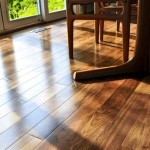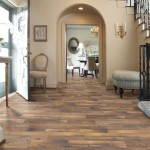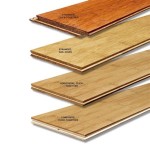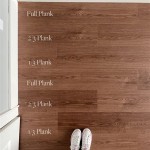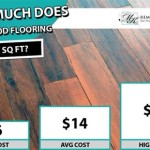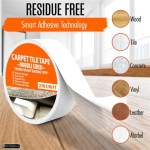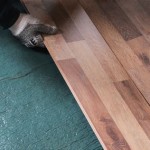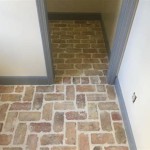How To Remove Sticky Residue From Wooden Floors
Sticky residue on wooden floors is a common household nuisance. It can be caused by a variety of factors, including spilled food and drinks, adhesives from labels or tape, pet accidents, or simply the accumulation of dirt and grime. Regardless of the cause, this residue not only mars the appearance of the floor but can also attract more dirt and become increasingly difficult to remove over time. Identifying the nature of the residue is the first step toward selecting the appropriate cleaning method. Some residues may be easily dissolved with warm water and mild soap, while others require more specialized solutions and techniques.
The type of wood flooring is also a significant consideration. Different types of wood, such as hardwood, softwood, or engineered wood, react differently to various cleaning agents. The finish on the floor, whether it is polyurethane, varnish, or oil-based, also influences the choice of cleaning products. Using the wrong cleaning solution can damage the finish or even the wood itself, leading to discoloration, warping, or other irreversible problems. Therefore, it is crucial to test any cleaning solution on an inconspicuous area of the floor before applying it to the entire affected area.
Preparation is key to successful sticky residue removal. Gather all necessary supplies beforehand to streamline the cleaning process. This may include warm water, a mild dish soap, white vinegar, rubbing alcohol, baking soda, a soft cloth or mop, a plastic scraper or putty knife, and a vacuum cleaner or broom. Protecting the surrounding area is also important. Place a drop cloth or towels to prevent the cleaning solution from damaging nearby furniture or carpets. Ensure adequate ventilation in the room by opening windows or turning on a fan, especially when using cleaning solutions with strong odors.
Identifying the Type of Sticky Residue
Before attempting any cleaning method, accurately identifying the type of sticky residue is paramount. Different types of residue respond differently to various cleaning solutions. The source of the residue often provides valuable clues. For instance, if the residue is located near a recently removed sticker or tape, the adhesive is likely the culprit. Food spills, especially sugary substances, often leave a sticky film that attracts dirt and grime. Pet accidents can also cause sticky residues, often accompanied by unpleasant odors.
Visual inspection can also help determine the type of residue. Adhesive residue often appears as a clear or slightly cloudy film. Food spills may be discolored or have a grainy texture. Grease or oily residue may appear shiny or leave a slippery surface. By carefully examining the residue's appearance and considering its location and potential sources, one can effectively narrow down the type of residue and select the most appropriate cleaning method. The presence of dirt or debris embedded in the residue can complicate the process, requiring initial cleaning to remove loose particles before addressing the sticky residue itself.
If the source of the sticky residue is unknown, a process of elimination may be necessary. Start with the mildest cleaning solutions and gradually increase the intensity as needed. This approach minimizes the risk of damaging the floor's finish. Documenting the results of each cleaning attempt can also be helpful in tracking progress and identifying the most effective solution. Consulting with a professional floor cleaning service may be beneficial if the residue persists or if there is uncertainty about the type of wood flooring or finish.
Effective Cleaning Methods
Several methods can be employed to remove sticky residue from wooden floors, ranging from simple solutions to more specialized techniques. The choice of method depends on the type of residue, the type of wood flooring, and the finish on the floor. It is always recommended to start with the gentlest method first and gradually increase the intensity as needed. Testing any cleaning solution on an inconspicuous area of the floor is crucial to prevent damage. Always wipe the area dry after cleaning to prevent water damage.
Warm Water and Mild Soap: This is the most basic and often the most effective method for removing light sticky residue. Mix a small amount of mild dish soap with warm water. Dip a soft cloth or mop into the solution, wring out excess water, and gently wipe the affected area. Avoid using excessive water, as it can damage the wood. Rinse the area with clean water and dry thoroughly with a clean cloth.
White Vinegar and Water: White vinegar is a natural cleaning agent that can dissolve many types of sticky residue. Mix equal parts white vinegar and water in a spray bottle. Lightly spray the solution onto the affected area and let it sit for a few minutes. Wipe away the residue with a clean cloth. Rinse the area with clean water and dry thoroughly. Vinegar is acidic and may not be suitable for all types of wood floors or finishes. Always test it in an inconspicuous area first.
Rubbing Alcohol: Rubbing alcohol is an effective solvent for removing adhesive residue. Apply rubbing alcohol to a clean cloth and gently rub the affected area. Avoid pouring alcohol directly onto the floor. The alcohol will dissolve the adhesive, making it easier to wipe away. Rinse the area with clean water and dry thoroughly. Rubbing alcohol is flammable and should be used with caution.
Baking Soda Paste: Baking soda is a mild abrasive that can help remove stubborn sticky residue. Mix baking soda with water to form a paste. Apply the paste to the affected area and let it sit for a few minutes. Gently scrub the area with a soft cloth or sponge. Rinse the area with clean water and dry thoroughly. Avoid using excessive pressure when scrubbing, as baking soda can scratch the floor's finish.
Commercial Adhesive Removers: Several commercial adhesive removers are specifically designed for removing sticky residue. Follow the manufacturer's instructions carefully when using these products. Test the product in an inconspicuous area first to ensure it does not damage the floor's finish. Ensure adequate ventilation when using commercial adhesive removers, as they may contain strong fumes.
Ice: For some types of sticky residue, such as gum or candle wax, freezing can make removal easier. Place a bag of ice on the affected area for a few minutes to harden the residue. Once the residue is frozen, gently scrape it away with a plastic scraper or putty knife. Avoid using metal scrapers, as they can scratch the floor.
Preventative Measures and Maintenance
Preventing sticky residue from accumulating on wooden floors is the most effective way to minimize the need for intensive cleaning. Regular maintenance and proactive measures can significantly reduce the likelihood of spills, stains, and other messes that lead to sticky residue.
Regular Sweeping and Vacuuming: Regularly sweeping or vacuuming the floor removes loose dirt, dust, and debris that can contribute to sticky residue. Use a soft-bristled broom or a vacuum cleaner with a floor brush attachment to avoid scratching the floor's finish. Vacuuming is particularly effective for removing pet hair and other small particles that can become embedded in sticky residue.
Prompt Spill Cleanup: Clean up spills immediately to prevent them from drying and becoming sticky. Use a clean, absorbent cloth to blot the spill from the outside in, avoiding spreading it further. For sticky spills, such as sugary drinks or sauces, rinse the area with warm water and dry thoroughly.
Using Floor Mats and Rugs: Placing floor mats and rugs in high-traffic areas, such as entryways and kitchens, can help protect the floor from spills and dirt. These mats can trap dirt and debris before they are tracked onto the wooden floor. Regularly clean or replace the mats to prevent them from becoming a source of dirt and grime.
Avoid Wearing Shoes Indoors: Encourage household members and guests to remove their shoes before entering the house. Shoes can track in dirt, mud, and other substances that contribute to sticky residue. Providing a shoe rack or mat near the entrance can make it easier for people to remove their shoes.
Using Furniture Pads: Place felt pads under the legs of furniture to prevent scratches and scuff marks on the floor. These pads also make it easier to move furniture without leaving behind sticky residue from adhesives or other substances.
Regular Floor Cleaning: Regularly clean the wooden floor with a damp mop and a pH-neutral floor cleaner specifically designed for wood floors. Avoid using harsh chemicals or abrasive cleaners, as they can damage the floor's finish. Follow the manufacturer's instructions carefully when using floor cleaners.
Proper Floor Sealing and Finishing: Ensure the wooden floor is properly sealed and finished to protect it from moisture and stains. Regularly inspect the finish for wear and tear and reapply as needed. A well-maintained finish provides a barrier against spills and makes it easier to clean up sticky residue.
By implementing these preventative measures and maintenance practices, one can significantly reduce the accumulation of sticky residue on wooden floors and keep them looking clean and well-maintained for years to come. A consistent cleaning routine will minimize the necessity for intensive cleaning efforts and preserve the beauty and longevity of the wood flooring.

How To Remove Glue From Wood Floors Pete S

How To Remove Sticky Residue From Hardwood Floors

4 Ways To Remove Adhesive From A Hardwood Floor Wikihow

Removing Glue Or Adhesive From Hardwood Floors The Speckled Goat

First Aid Remove Sticky Residue Simple Decorating Tips

How To Remove Sticky Residue From Hardwood Floors

4 Ways To Remove Adhesive From A Hardwood Floor Wikihow

Removing Glue Or Adhesive From Hardwood Floors The Speckled Goat

Flooring How Can I Remove Carpet Adhesive From Hardwood Floors Home Improvement Stack Exchange

4 Reasons Your Floors Are Sticky And How To Fix Them
See Also
